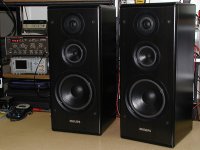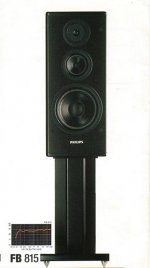Due my evolvement with electronics professionally, subjective questions is always something which I must to avoid.
But here there is one question regarding a subject which is hard to be answered just by the law of Ohm.
I have just repaired my speakers with new foam surrounds (midrange and woofer), and even both crossover networks were also inspected and few parts were replaced with equal NOS quality parts.
This is my second day of testing them and thankfully all my repairs are 100% successful and both speakers are back at it former glory.
My test music is mostly electronic and actually the Equinox of JM Jarre, as it has a tremendously wide range of acoustical frequencies’ in it.
My amplifier an Kenwood at 2x115 RMS is driving my speakers effortless at ¼ of the volume pot, and at 1/3 of the volume pot my woofers becomes very alive, and at that sweet spot regarding volume control adjustment I do get max fidelity which is also not compressed, because these speakers has even higher potentials in watt.
My new foam surrounds are soft and compatible, therefore after four complete hours of testing, I think that I have nothing more to expect regarding acoustical influence from them.
And now here is the one millions dollars question, regarding this fabric protector influence.
I never used all those 22 years these front covers of fabric protector, and today that I did put them back on, I think that I remembered the why?
I have the feeling that they cause a compression at anything below the 80Hz and as chain reaction the stereophonic effect gets less audible because the bass becomes less directional.
From the other hand the tweeter and midrange drives seem as totally uninfluenced from the fabric protector.
Therefore I need to ask for opinions mostly as verification in the question if my own ear drums are playing games to me or not?
I did a correct speakers cabinet placement in my room and also they are set at the proper height from the ground that is suggested by their manufacturer.
My second puzzle is about making two dedicated floor stands base, and my head had stuck in the selection between wood or steel as materials?
I am after mostly for a uniform appearance, because now I have the one over a small table and the second cabinet over a chair.
But here there is one question regarding a subject which is hard to be answered just by the law of Ohm.
I have just repaired my speakers with new foam surrounds (midrange and woofer), and even both crossover networks were also inspected and few parts were replaced with equal NOS quality parts.
This is my second day of testing them and thankfully all my repairs are 100% successful and both speakers are back at it former glory.
My test music is mostly electronic and actually the Equinox of JM Jarre, as it has a tremendously wide range of acoustical frequencies’ in it.
My amplifier an Kenwood at 2x115 RMS is driving my speakers effortless at ¼ of the volume pot, and at 1/3 of the volume pot my woofers becomes very alive, and at that sweet spot regarding volume control adjustment I do get max fidelity which is also not compressed, because these speakers has even higher potentials in watt.
My new foam surrounds are soft and compatible, therefore after four complete hours of testing, I think that I have nothing more to expect regarding acoustical influence from them.
And now here is the one millions dollars question, regarding this fabric protector influence.
I never used all those 22 years these front covers of fabric protector, and today that I did put them back on, I think that I remembered the why?
I have the feeling that they cause a compression at anything below the 80Hz and as chain reaction the stereophonic effect gets less audible because the bass becomes less directional.
From the other hand the tweeter and midrange drives seem as totally uninfluenced from the fabric protector.
Therefore I need to ask for opinions mostly as verification in the question if my own ear drums are playing games to me or not?
I did a correct speakers cabinet placement in my room and also they are set at the proper height from the ground that is suggested by their manufacturer.
My second puzzle is about making two dedicated floor stands base, and my head had stuck in the selection between wood or steel as materials?
I am after mostly for a uniform appearance, because now I have the one over a small table and the second cabinet over a chair.
Attachments
Last edited:
It seems unlikely that the fronts cause any difference in the bass usually they just attenuate the highest frequencys a little. They could cause some small bumps and dips in the treble because of diffraction in the mounting.
1) Bass at 80 Hz from your speakers is omnidirectional. Assuming the grill fabric is acoustically transparent, the only effects would be as dukanvadet mentioned, slight HF attenuation and diffraction due to the screen frame.1) I have the feeling that they cause a compression at anything below the 80Hz and as chain reaction the stereophonic effect gets less audible because the bass becomes less directional.
From the other hand the tweeter and midrange drives seem as totally uninfluenced from the fabric protector.
Therefore I need to ask for opinions mostly as verification in the question if my own ear drums are playing games to me or not?
2)My second puzzle is about making two dedicated floor stands base, and my head had stuck in the selection between wood or steel as materials?
2) Either will work, but steel would be more likely to "ring". That said, I use stands using steel tubes with no audible ringing.
1) Bass at 80 Hz from your speakers is omnidirectional. Assuming the grill fabric is acoustically transparent
Regarding the grill fabric it is the original that came with the speakers, therefore it has even the blessings of the manufacturer. 🙂
I would expect according my impression that LF gets mostly some damage at medium to high sound volume, because the moving air volume are getting close to the limits of the fabric transparency.the only effects would be as dukanvadet mentioned, slight HF attenuation and diffraction due to the screen frame.
The tweeter and mid-range drive, does not push much quantity of air, and logically I would expect the grill fabric to seem as more transparent to them.
2) Either will work, but steel would be more likely to "ring". That said, I use stands using steel tubes with no audible ringing.
This is a good point that I will investigate too, it looks that the wooden ones from OAK is another popular solution, but my fear is that due my speakers design (air sealed cabinets) that the wooden one could possibly influence LF by a negative way.
My speakers came with fabric feet which have now completely deteriorate and I had to remove them yesterday.
Then I discovered that my cabinets is not that flat any more, possibly they absorbed moister due the years and they are slightly deformed.
Therefore I am in need for a fresh set of wide rubber feet which would isolate the cabinet for it stand base.
I am attaching the picture of their original stand, of which probably I will copy it design.
PHILIPS FV815
Attachments
Your impression is measurably incorrect, a simple sine wave test at various levels with a dB meter left in the same position while you put the grill on and off would show that in a moment.I would expect according my impression that LF gets mostly some damage at medium to high sound volume, because the moving air volume are getting close to the limits of the fabric transparency.
At high drive levels speakers do exhibit "power compression", as voice coils heat up their impedance rises, and (most) amplifiers deliver less power into higher impedance loads, but grill cloth won't affect output differently at different levels.
Hi,
That stand looks a little too tall to me. Blutack the speaker
to the stand, its much less likely to get knocked over.
There are a myriad of stand designs you could build.
MDF being probably the simplest material, sprayed black.
rgds, sreten.
That stand looks a little too tall to me. Blutack the speaker
to the stand, its much less likely to get knocked over.
There are a myriad of stand designs you could build.
MDF being probably the simplest material, sprayed black.
rgds, sreten.
Hi,
That stand looks a little too tall to me. Blutack the speaker
to the stand, its much less likely to get knocked over.
There are a myriad of stand designs you could build.
MDF being probably the simplest material, sprayed black.
rgds, sreten.
I have analyze this stand dimensions due pictures and size comparison with the larger speakers of this series.
This is my numbers.
270x270 Top plate
340x340 bottom plate
480 mm Height (with out spikes)
Luckily I do have 30mm MDF plate about four square meters, but I can not think that I could made the bottom plate with curves which will make it look slick as the commercial ones.
Last edited:
- Status
- Not open for further replies.
- Home
- Loudspeakers
- Multi-Way
- Subjective question: 3 Way 150W speakers & fabric protector influence?

